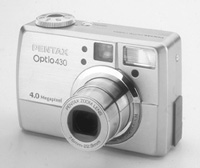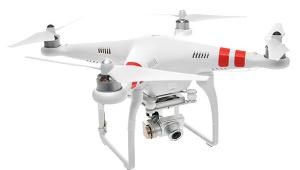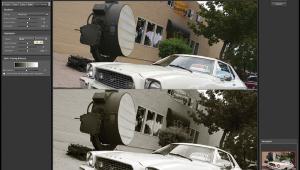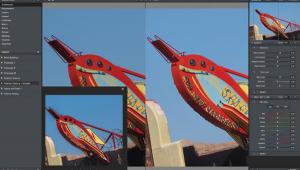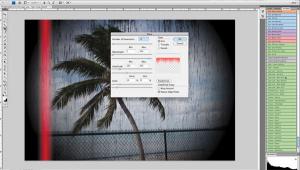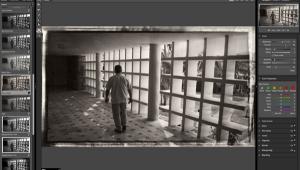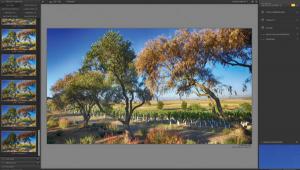Digital Innovations
Film Photography Meets Digital Imaging
"Life is a series of dogs."--George Carlin As regular readers know, most of my photographic output is in some kind of digital form, but only a portion of those images were originally captured using digital media. Over time, my ratio of film vs. digital capture has decreased and will change drastically when I find the "digital camera of my dreams," but who knows how long that will take. My point is that even those photographers who only shoot film can benefit from some kind of digital intervention because if you want to make prints, only you know how they should look. This goal can be accomplished in a traditional darkroom, but is more easily attained in the digital one, especially when you want to make lots of small color prints. Recently, I photographed a Hallo-ween costume contest for dogs. It was a fun day at the mall and I enjoyed "going to the dogs" and trying to make portraits of them in their costumes using a Canon Elan 7E and Fuji color negative film. I dropped the film off at a minilab that just opened in town and while the prints the shop gave me back were OK, they weren't as good as I thought they should be. |
|||
Since the negatives looked great, I scanned one of them using a Nikon CoolScan IV ED. After opening it in Adobe Photoshop 6.01, I slightly adjusted Levels (Image>Adjust> Levels) before printing on 4x6" Epson Photo Paper using the new Epson Stylus Photo 820 I'm testing. The entire process from inserting the film holder into the scanner and making the print took less than 10 minutes. I was not surprised that the digital print was sharper and more true to subject matter in color density and accuracy than the ones from the minilab. All three are darn good reasons why you should consider a plunge into the digital darkroom. Even more important, if I wanted to make 100 4x6" prints of this file, I could attach the roll adapter that Epson bundles with some of their photo printers, load a 4" roll of Photo Paper, and crank out as many snapshot-sized prints as I needed. Plug-In Of The Month Just as I recommend you have an image test file for evaluating new printers, inks, and media, I think you should also have a test image for evaluating color. My test file came to me inadvertently with a photograph made by eDigitalPhoto.com contributor John Stewart inside the FAO Schwartz toy store in Orlando during last year's PMA show. I always test color correction software using this digital camera file that was made under all kinds of mixed lighting conditions. Although Stewart used the camera's built-in flash, skin tone and every other color in the photograph was out of kilter. |
|||
To see how it would fare, I opened iCorrect Professional (Filter>Pictographics>iCorrect Professional). Using its simple interface, I selected the skin tone "Memory Color," clicked on my face in the preview windows, and instantly produced a corrected file. Previously I had spent more than 20 minutes working with this same file and another plug-in along with some manual tweaking. What was impressive to me was that the overall color, including skin tones, was better with iCorrect Professional than the file that all my hard work produced and took significantly less time. Other Memory Colors include Neutrals, Sky, and Foliage, and you can add your own or customize the built-in ones to match your preferences. iCorrect Professional clearly deserves to be Plug-in of the Month, and maybe even Plug-in of the Year. Color Me Plug-In You can use Color Mechanic to adjust skin tones without disturbing a photograph's overall color balance or change the color of a particular item in a picture, such as clothing, house color, or making the grass a little greener. You can also use Color Mechanic to separate objects that have closely related colors by shifting the color of one or the other. This plug-in is available in standard and Pro versions. The Pro version supports 16 bit/channel image formats and CMYK while the standard version is 8 bit/channel RGB only. Prices are $49.95 and $29.95, respectively. You can find more information at www.colormechanic.com, including documentation, sample images, a message board, and free demo downloads. B&W Plug-In Big Pixels, Little Package Of more use are the 2240x1680 resolution images that can capture images at ISO equivalencies of 100 and 200. You can squeeze up to five "Best" quality images out of the bundled 16MB CompactFlash card. In the ubiquitous web format of 640x480 you can store 200 of these puppies on a 16MB card. The built-in flash offers redeye reduction and a Night mode. For more critical applications, the Optio 430 allows light levels to be checked by displaying exposure in histogram format on its 1.6" LCD screen during shooting and playback, which is unusual for a camera in this class. The camera also offers PRINT Image Matching compatibility to make sure the finished prints look like the pictures you thought you were making--something mentioned at the top of this month's column. For more information, visit www.pentax.com. Archival Ink & Paper How Much Is That Digital
Darkroom In The Window? For some computer owners this may just mean a few hardware or software upgrades along with adding a few peripherals, but if you're starting from scratch MacWorld magazine estimates the cost can go as high as $6500, depending on your digital imaging goals. It doesn't have to cost that much. I've been using a budget-priced Windows XP computer that has better features and performance than more expensive systems. eMachines' top of the line T4155 computer uses an Intel Pentium IV 1.5GHz processor and has 256MB RAM, a 12x CD-RW drive, a 12x DVD drive, a 60GB hard drive, fax/modem as well as an Ethernet network card for DSL/cable Internet connectivity. The T4155 comes pre-loaded with Microsoft Windows XP along with a bundle of non-imaging software and costs less than $800. I connected it to a Samsung 15" flat panel screen and am putting it through its paces here at the Pixel Palace. I'll let you know how it goes. For more information on eMachines, visit www.emachines.com. |
